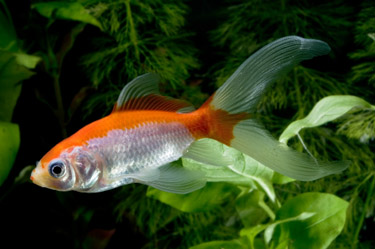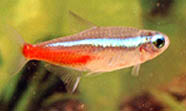Fish: Feeding
Unlike humans, fish have the ability to eat continuously, digest what they need, and excrete the rest. This means it is very easy to overfeed—not the fish, but the aquarium. It is surprising how little food fish actually need. Unlike humans, fish are not fighting gravity or maintaining a high body temperature. Hence, little sustenance is needed to grow and swim around.
Most commercial fish foods contain all the nutrients and trace elements pet fish require. It is, however, recommended to choose a good quality one, where the manufacturer has carried out research to find the ideal level of nutrients, including vitamins and minerals, which fish require for a long and healthy life. It is important to follow the instructions on the packaging, which usually recommends two small feeds per day, and to remove any leftovers from previous feeding.
Research has shown that to stay fit and healthy and enjoy maximum longevity, fish need a wide range of essential nutrients. Without the right amount of these nutritional "building blocks", fish may cease to grow, lose colour, stop breeding, become susceptible to disease and, in certain circumstances, might even die. In their natural habitats, fish feed on a variety of plants, insects or other water-borne live foods, which are generally in plentiful supply and high in nutrients. In the confines of an aquarium, live foods can introduce disease and infestation, and problems of water pollution from a high level of fish excreta can cause stress and disease in the fish.

Nutrient Requirements
The relative amount of food needed by fish differs greatly from human beings. Humans are warm-blooded, and up to 70 percent of the calories from food are used to generate heat needed for survival. Fish, on the other hand, are cold-blooded and do not have this requirement. As fish are supported in water, they do not have to use a lot of energy offsetting the effects of gravity. As a result, fish need relatively little high calorie ingredients, such as carbohydrates, in their diet.
Another difference between human and fish nutrition is the requirement in vitamins. Fish need much greater relative amounts; this is probably a reflection of the greater sophistication of the human digestive system, where vitamins can be used more efficiently.
Proteins are built from nitrogen compounds called amino acids, which are essential for growth and the rebuilding of body tissues. However, not all proteins are easily digested and utilized by fish. Some poorer quality proteins are utilized primarily as a source of calories, resulting in the release of ammonia, which is toxic to fish. The quality and digestibility of the protein present in fish food is therefore critically important. Essential amino acids cannot be synthesised by the fish and therefore must be present in food. Two such essential amino acids are lysine and methionine.
The best and easiest way of feeding fish is to provide a complete and balanced diet free from infestation. A key factor for this is the percentage of water in the food. Micro-organisms cannot develop at a moisture levels of 4 percent or less, and flaked fish foods should therefore have a moisture level below 4 percent. Studies have shown that once prepared food is put into the aquarium, the nutrients very quickly leach out and are therefore no longer available to the fish. The longer the food is in the water, the greater the nutrient loss. This means that fish that feed in the middle and bottom of the tank may be getting their food after many of the water-soluble nutrients have been leached out.
Other foods: It's good for most fish to eat some frozen or live brine shrimp and a few live black worms. Try to alternate feeding live or frozen brine shrimp with live black worms. One day most fish get brine shrimp, and the next day they get live black worms.
Avoiding Pollution
The danger of pollution from uneaten food and excreta is always a risk in any aquarium, which is why proper equipment, good water preparation and maintenance are so important. A properly prepared fish food can help to minimize the risk of pollution in several ways. A highly palatable fish food will be eagerly accepted by the fish, which means less uneaten food remains to pollute the water. A highly digestible formulation, which is utilized efficiently by the fish will also convert ahigher proportion into growth and energy, thus resulting in less waste from the fish to pollute the tank.
How Often to Feed?
The frequency of feeding depends on the type of fish you have. Carnivores, for example, like to eat one big meal a day and then lie around digesting it, whereas herbivores tend to nibble all day. If your tank contains a mixture of fish (community tank), then a compromise is to feed two or three times a day. If you breed fish, you need to give several small meals a day, as fry have big appetites but small stomachs.

If you miss a feed, or even several days feeding, don't worry. In nature, fish often experience erratic food availability. You would, however, need to make arrangements if you go away from home for more than a few days.
How Much to Feed?
The best and easiest way of deciding how much to feed is to observe your fish during and just after feeding. If there is no food left on the surface of the water after a few minutes, give a little more until the fish stop eating, then remove the excess food. Soon you will be able to judge quite accurately how much your fish need. Food that sinks to the bottom and is not eaten will cause water pollution, so be sure all the food is eaten. Use your net to remove the food that is not eaten after ten minutes. It's fun to feed smaller fish a few of Tetra's Delecta Freeze Dried Blood Worms for desert.
[ Search Articles ] [ Article Index ]
